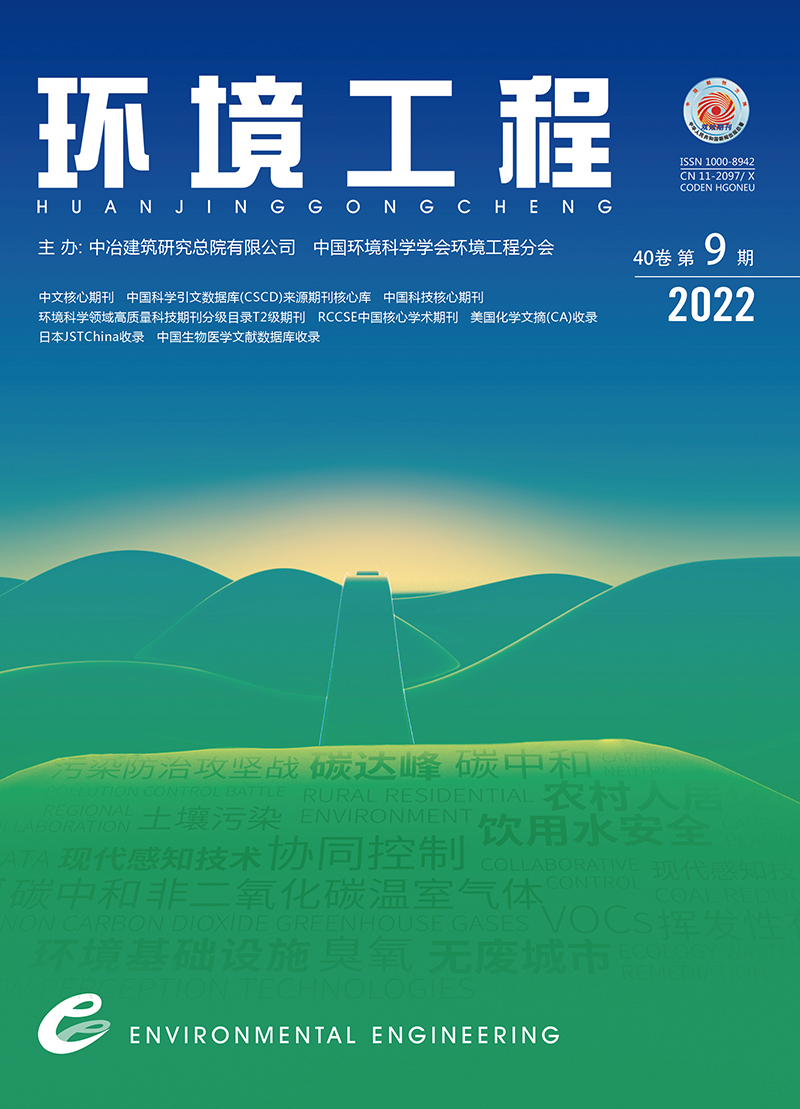| [1] |
LI Y Y,CHANG M,DING S S,et al.Monitoring and source apportionment of trace elements in PM2.5:implications for local air quality management[J].Journal of Environmental Management,2017,196:16-25.
|
| [2] |
HUANG H T,GAO L R,XIA D,et al.Characterization of short- and medium-chain chlorinated paraffifins in outdoor/indoor PM10/PM2.5/PM1.0 in Beijing,China[J].Environmental Pollution,2017,225:674-680.
|
| [3] |
ZHOU Y,CHENG S Y,CHEN D S,et al.Temporal and spatial characteristics of ambient air quality in Beijing,China[J].Aerosol and Air Quality Research,2015,15:1868-1880.
|
| [4] |
DING X X,KONG L D,DU C T,et al.Long-range and regional transported size-resolved atmospheric aerosols during summertime in urban Shanghai[J].Science of Total Environment,2017,583:334-343.
|
| [5] |
YANG B Y,GUO Y,BLOOM M S,et al.Ambient PM1 air pollution,blood pressure,and hypertension:insights from the 33 communities Chinese Health Study[J].Environmental Research,2019,170:252-259.
|
| [6] |
LIN H L,TAO J,DU Y D,et al.Particle size and chemical constituents of ambient particulate pollution associated with cardiovascular mortality in Guangzhou,China[J].Environmental Pollution,2016,208(Pt B):758-766.
|
| [7] |
YANG M,CHU C,BLOOM M S,et al.Is smaller worse? New insights about associations of PM1 and respiratory health in children and adolescents[J].Environment International,2018,120:516-524.
|
| [8] |
WANG H L,ZHU B,SHEN L J,et al.Water-soluble ions in atmospheric aerosols measures in five sites in the Yangtze River Delta,China:size-fractionated,seasonal variation and sources[J].Atmospheric Environment,2015,123:370-379.
|
| [9] |
XU L L,DUAN F K,HE K B,et al.Characteristics of the secondary water-soluble ions in a typical autumn haze in Beijing[J].Environmental Pollution,2017,227:296-305.
|
| [10] |
ROGULA-KOZOWSKA W,MAJEWSKI G,WIDZIEWICZ K,et al.Seasonal variations of PM1-bound water concentration in urban areas in Poland[J].Atmospheric Pollution Research,2019,10(1):267-273.
|
| [11] |
PADOAN S,ZAPPI A,ADAM T,et al.Organic molecular markers and source contributions in a polluted municipality of north-east Italy:extended PCA-PMF statistical approach[J].Environmental Research,2020,186:109587.
|
| [12] |
ARUB Z,SINGH G,HABIB G,et al.Highly significant impact of mineral dust on aerosol hygroscopicity at New Delhi[J].Atmospheric Environment,2021,254:118375.
|
| [13] |
林瑜,叶芝祥,杨怀金,等.成都市中心城区大气PM1的污染特征及来源解析[J].中国环境科学,2017,37(9):3220-3226.
|
| [14] |
LANG J L,LI S Y,CHENG S Y,et al.Chemical characteristics and sources of submicron particles in a city with heavy pollution in China[J].Atmosphere,2018,9(10):388.
|
| [15] |
ZHANG Y Y,LANG J L,CHENG S Y,et al.Chemical composition and sources of PM1 and PM2.5 in Beijing in autumn[J].Science of Total Environment,2018,630:72-82.
|
| [16] |
LI Z R,NIE D Y,CHEN M D,et al.Seasonal variation of oxidative potential of water-soluble components in PM2.5 and PM1 in the Yangtze River Delta,China[J].Air Quality Atmosphere & Health,2021,14:1825-1836.
|
| [17] |
XIA Y J,TAO J,ZHANG L M,et al.Impact of size distributions of major chemical components in fine particles on light extinction in urban Guangzhou[J].Science of the Total Environment,2017,587/588:240-247.
|
| [18] |
FENG X,WEI S,WANG S.Temperature inversions in the atmospheric boundary layer and lower troposphere over the Sichuan Basin,China:climatology and impacts on air pollution[J].Science of the Total Environment,2020,726:138579.
|
| [19] |
GUO M T,CAI X H,SONG Y.Characteristics of low wind speed meteorology in China[J].Acta Scientiarum Nauralium Universitatis Pekinsis,2016,52(2):219-226.
|
| [20] |
LIAO T T,GUI K,JIANG W T,et al.Air stagnation and its impact on air quality during winter in Sichuan and Chongqing,southwestern China[J].The Science of the Total Environment,2018,635:576.
|
| [21] |
CHENG X,HUANG Y,ZHANG S P,et al.Characteristics,sources,and health risk assessment of trace elements in PM10 at an urban site in Chengdu,Southwest China[J].Aerosol and Air Quality Research,2017,18(2):357-370.
|
| [22] |
WANG J J,HUANG Y,LI T,et al.Annual Characteristics,source analysis of PM1 bound potentially harmful elements in the eastern district of chengdu,China[J].Archives of Environmental Contamination and Toxicology,2020,79:177-183.
|
| [23] |
ZHAO S P,YIN D Y,YU Y,et al.PM1 chemical composition and light absorption properties in urban and rural areas within Sichuan Basin,southwest China[J].Environment Pollution,2021,280:116970.
|
| [24] |
WANG Y S,YAO L,WANG L L,et al.Mechanism for the formation of the January 2013 heavy haze pollution episode over central and eastern China[J].Science China Earth Sciences,2014,57(1):14-25.
|
| [25] |
樊啸辰,郎建垒,程水源,等.北京市大气环境PM2.5和PM1及其碳质组分季节变化特征及来源分析[J].环境科学,2018,10(10):4430-4438.
|
| [26] |
QIAO T,ZHAO M F,XIU G L,et al.Seasonal variations of water soluble composition (WSOC,Hulis and WSIIs) in PM1 and its implications on haze pollution in urban Shanghai,China[J].Atmospheric Environment,2015,123:306-314.
|
| [27] |
TAO J,SHEN Z X,ZHU C S,et al.Seasonal variations and chemical characteristics of sub-micrometer particles (PM1) in Guangzhou,China[J].Atmospheric Research,2012,118:222-231.
|
| [28] |
毛红梅,张凯山,第宝锋,等.成都市大气污染物排放清单高分辨率的时空分配[J].环境科学学报,2017,37(1):23-33.
|
| [29] |
ZHANG R Y,WANG G H,GUO S,et al.Formation of urban fine particulate matter[J].Chemical Reviews,2015,115(10):3803-3855.
|
| [30] |
林雅洁.我国PM2.5中可溶性无机离子组分的来源及特点[J].广东化工,2017,44(8):136-138.
|
| [31] |
SHEN Z X,ARIMOTO R,CAO J J,et al.Seasonal variations and evidence for the effectiveness of pollution controls on water-soluble inorganic species in total suspended particulates and fine particulate matter from Xi’an,China[J].Journal of Air & Waste Management Assosiation,2008,58:1560-1570.
|
| [32] |
RUSSELL A G,MCRAE G J,CASS G R.Mathematical modeling of the formation and transport of ammonium nitrate aerosol[J].Atmospheric Environment[J].1983,17(5):949-964.
|
| [33] |
ZHAO P S,DONG F,HE D,et al.Characteristics of concentrations and chemical compositions for PM2.5 in the region of Beijing,Tianjin,and Hebei,China[J].Atmospheric Chemistry and Physics,2013,13(9):4631-4644.
|
| [34] |
WANG H B,TIAN M,LI X H,et al.Chemical Composition and Light Extinction Contribution of PM2.5 in Urban Beijing for a 1-Year Period[J].Aerosol and Air Quality Research,2015,15:2200-2211.
|
| [35] |
ZHANG J K,CHENG M T,JI D S,et al.Characterization of sub-micron particles during biomass burning and coal combustion period in Beijing,China[J].Science of the Total Environment,2016,562:812-821.
|
| [36] |
WANG Y,ZHANG G S,TANG A H,et al.The ion chemistry and the source of PM2.5 aerosol in Beijing[J].Atmospheric Environment,2005,39(21):3771-3784.
|
| [37] |
YAO X H,CHAN C K,FANG M,et al.The water-soluble ionic composition of PM2.5 in Shanghai and Beijing,China[J].Atmospheric Environment,2002,36(26):4223-4234.
|
| [38] |
张丹,翟崇治,周志恩,等.重庆市主城区不同粒径颗粒物水溶性无机组分特征[J].环境科学研究,2012,25(10):1099-1106.
|
| [39] |
CLEGG S L,BRIMBLECOMBE P,WEXLER A S.Thermodynamic model of the system H+-NH4+-SO42--NO3--H2O at tropospheric temperatures[J].The Journal of Physical Chemistry A,1998,102(12):2137-2154.
|
| [40] |
GENG N B,WANG J,XU Y F,et al.PM2.5 in an industrial district of Zhengzhou,China:chemical composition and source apportionment[J].Particuology,2013,11(1):99-109.
|
| [41] |
孙有昌,姜楠,王申博,等.安阳市大气PM2.5中水溶性离子季节特征及来源解析[J].环境科学,2020,41(1):77-83.
|
| [42] |
HAN Y M,DU P X,CAO J J,et al.Multivariate analysis of heavy metal contamination in urban dusts of Xi’an,Central China[J].Science of the Total Environment,2006,355:176-186.
|
| [43] |
闫广轩,张靖雯,雷豪杰,等.郑州市大气细颗粒物中水溶性离子季节性变化特征及其源解析[J].环境科学,2019,40(4):1545-1552.
|


 Login
Login Register
Register E-alert
E-alert






 DownLoad:
DownLoad: